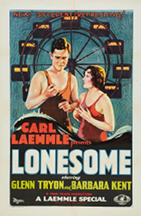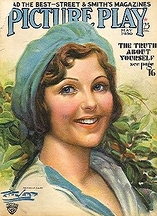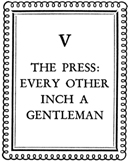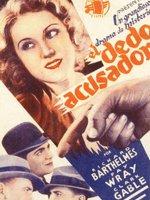Here are 10 things you should know about Lilyan Tashman, born 125 years ago today. Though never an A-list star, she nonetheless held the public’s interest with her lavish lifestyle and public feuds.
Tag: Richard Barthelmess
Goodbye to another glorious gal: Barbara Kent
 Some years ago, we had the pleasure of viewing Lonesome, a silent-talkie hybrid that was released in 1928. It’s not an easy movie to catch; as far as we know, the George Eastman House in Rochester, New York, has one of the few extant prints. (Someone seems to have loaded Lonesome up on YouTube, and we suppose that’s better than not seeing it at all, but just barely.)
Some years ago, we had the pleasure of viewing Lonesome, a silent-talkie hybrid that was released in 1928. It’s not an easy movie to catch; as far as we know, the George Eastman House in Rochester, New York, has one of the few extant prints. (Someone seems to have loaded Lonesome up on YouTube, and we suppose that’s better than not seeing it at all, but just barely.)
Lonesome could not be more charming. Its appeal is based in large part on the fact that much of it was filmed on Coney Island, and any glimpse of that magical setting as it was in the 1920s is to be treasured.
But the plot of the picture is engaging, too. It tells the tale of two lonely Manhattanites who experience a chance meeting at Coney Island and go on to spend a magical day together before getting separated that evening, with neither having learned the other’s last name. In a city of millions, will they ever manage to find each other? (If you think we’re going to tell you how it turns out, you can think again. No blabbermouths, we.)
Lonesome was originally released as a silent picture, but with all the fuss over the new sound technology, it was decided to bring back all involved parties to film three scenes with synchronized music and dialogue. So it’s not quite a silent and not quite a talkie.
But it’s certainly delightful, in our opinion, and we encourage you, if you ever have the opportunity, to see it (in a theatre and not streaming online, if at all possible).
 But you might well be wondering why we’re mentioning what is today a rather obscure picture now? Well, we’re sad to report that it’s because the movie’s leading lady, Barbara Kent, one of Universal Studios’ original contract stars and the final surviving WAMPAS Baby Star of 1927, died a week ago yesterday at the age of 103.
But you might well be wondering why we’re mentioning what is today a rather obscure picture now? Well, we’re sad to report that it’s because the movie’s leading lady, Barbara Kent, one of Universal Studios’ original contract stars and the final surviving WAMPAS Baby Star of 1927, died a week ago yesterday at the age of 103.
The Canadian-born Kent (her birthname was Barbara Cloutman) was not, admittedly, the biggest of names, even at the height of her career, but she made her mark, making eight or nine silents before successfully navigating the switch to talking pictures. She made 25 sound movies following her appearance in Lonesome, but retired from acting in 1935.
Among Kent’s most notable films were her screen debut in Flesh and the Devil (1926), with John Gilbert and Greta Garbo; a pair of starring roles opposite Harold Lloyd, in 1929’s Welcome Danger and Feet First a year later; a supporting role in Indiscreet (1931), which starred Gloria Swanson; and Emma, which featured Myrna Loy and Marie Dressler.
 In the course of her nine-year career, Kent also worked alongside Douglas Fairbanks Jr., Richard Barthelmess, Edward G. Robinson, Charles “Buddy” Rogers, Andy Devine, James Gleason, Ben Lyon, Gilbert Roland, Noah Beery, Victor Jory, Dickie Moore, Monte Blue, Wallace Ford, Ward Bond, Arthur Lake, and Rex the Wonder Horse. That may not qualify as a Hall of Fame roster of co-stars, but many an actress has done worse.
In the course of her nine-year career, Kent also worked alongside Douglas Fairbanks Jr., Richard Barthelmess, Edward G. Robinson, Charles “Buddy” Rogers, Andy Devine, James Gleason, Ben Lyon, Gilbert Roland, Noah Beery, Victor Jory, Dickie Moore, Monte Blue, Wallace Ford, Ward Bond, Arthur Lake, and Rex the Wonder Horse. That may not qualify as a Hall of Fame roster of co-stars, but many an actress has done worse.
After retiring, Kent refused virtually all interviews about her years in Hollywood—one notable exception was the time she afforded author Michael G. Ankerich, who profiled Kent in The Sound of Silence: Conversations with 16 Film and Stage Personalities Who Bridged the Gap Between Silents and Talkies—as she settled into a successive pair of happy marriages—first to Harry Edington, a Hollywood agent, whom she wed in 1932, and then, some years after Edington’s death in 1949, she married Jack Monroe, a Lockheed engineer. Aside from evading would-be interviewers, Kent reportedly spent her free time in her golden years as a golfer and a pilot.
For more on Kent’s life and career, give this New York Times obit a look.
In Your Hat, pt. 5
Here’s Chapter 5 of In Your Hat, the 1933 tell-all memoir by Hat Check Girl to the Stars, Renee Carroll, in which she dishes on 1930s press agentry and Broadway columnists such as Walter Winchell, Louis Sobol, Mark Hellinger, and others.

THE press boys are divided into two sections. Those who are in and those trying to get in. Those already in are such lights as Winchell, Hellinger, Sobol, Skolsky, Yawitz, Sullivan and the rest. On the other side of the gate, trying day and night to crash it, are a host of diligent workers, most of them intelligent youngsters who have experienced softening of the brain.
 The press agents, who like to think of themselves as connected with the newspaper business, are in such great numbers that it would be difficult to name them all. But the majority of the best ones are connected with the films.
The press agents, who like to think of themselves as connected with the newspaper business, are in such great numbers that it would be difficult to name them all. But the majority of the best ones are connected with the films.
It has been said that if you scratch a star you’ll find a press agent, and if you scratch a press agent, he’ll thank you. The press agent is a nervous, erratic type who works in twenty-four hour shifts (while you sleep) and succeeds in bringing the name of his client before the public—or gets thrown into the street in the attempt. If you walk along and see a man dusting himself off, you can lay odds it’s a press agent with another idea gone wrong.
The reason I say that most press agents are in the preliminary stages of dementia praecox is because they write things that under ordinary circumstances they would admit were insane, and yet they expect editors to print the stuff without question. Their efforts are so frantic that in no time at all they get farfetched and nutty, and the result is shown partly in the collection of press-agent’s squibs that I have collected from time to time. All of the copy is from movie press agents gone wrong.
For example, one of them, having nothing else to do, will write a story and send it to the editors expecting them to print it. This one is an extract of a story sent from Hollywood:
“…the physical measurements of 124 of the chorus girls under contract to this studio reveal that they have grown, on an average, one-fourth of an inch in height in the past eight months since most of them were placed under contract. There has also been an average of increase of three pounds in weight despite the strenuous dancing which is part of their daily routine.”
This startling item may make the nation growth-conscious and it may, on the other hand, make the press agent obnoxious.
Another great news break for managing editors comes printed in sotto voce type, telling the gaping world that an English actor who appeared as a butler in many films “has received letters offering him jobs as the major-domo in the service of many Park Avenue dowagers.” It goes on to say that the actors has received 279 offers.
Another story teller sends out a squib saying that love scenes have not suffered with talking films, for a hero and a heroine meeting for the first time on the set no longer find it necessary to simulate warmth in their celluloid caresses. Science has come to Cupid’s assistance in the guise of a portable set-warmer, which sends gales of hot air into chilly stages. SIZZLING LOVE SCENES ARE BECOMING A REALITY AT TALKIE STUDIOS! (The capital letters are the press agent’s.) Operated by gas and electricity, the heating units, etc. An electric fans blows hot air in any desired direction.
They might have saved expenses and put the writer on the scene.
Read More »
Cinematic slang: Joint
 It can be fascinating to note the language in old pictures. Many of the usages are familiar, if musty, but occasionally one is surprised to hear a word or phrase one would have guessed was a more recent coinage.
It can be fascinating to note the language in old pictures. Many of the usages are familiar, if musty, but occasionally one is surprised to hear a word or phrase one would have guessed was a more recent coinage.
Take the term “joint,” as in the phrase, “A Spike Lee Joint.” Like us, you may have assumed that usage was fairly contemporary.
However, we came across it some months back in a 1932 picture, The Finger Points.
In the film, Richard Barthelmess portrays a serious, gentlemanly reporter from the South who’s new to the big city. He quickly makes his mark at the major daily at which he’s been hired by covering the gangster beat. Regis Toomey is the office cut-up. He’s a reporter, too, but he’s not terribly diligent or motivated. He even warns Barthelmess against sticking his neck by going after the mob too hard.
Fay Wray‘s a reporter for the same paper, and both men are sweet on her, natch. (Clark Gable‘s in the picture, too, but not in this scene.)
Barthelmess wins her heart, but Toomey keeps pitching and when Barthelmess disappoints Wray by becoming a little too close to the gangsters he’s covering (he appears to be on the take with them), she tells Toomey in a weak moment that if he’ll get serious about his career, if he’ll do some legitimate, hard-hitting reporting, she’ll reconsider his offer of marriage.
Toomey does just that, and when he rushes over to Wray’s apartment to show her the blockbuster, front-page story he’s written, he finds Barthelmess there. Barthelmess is sympathetic, but explains to Toomey that he and Wray are about to go away together, that they intend to be married.
“I’m sorry,” Barthelmess says. “I really am. She’s a great girl.”
“You telling me?” Toomey responds, despondent. “Here’s my story all over the front page — swellest joint I ever wrote! — and now it doesn’t mean a thing.”
We somehow like the idea of Spike Lee using classic lingo, a term that’s been around for decades, rather than recently coined slang (though we wonder if Lee was aware of the term’s history).
A friend of ours is the North American editor of the Oxford English Dictionary (one thing we really love about life in NYC is that we occasionally get to make the acquaintance of such prominent, accomplished, and knowledgable individuals as this friend). He’s very generous with his estimable knowledge and expertise, and we, in turn, very occasionally share these little “discoveries” of ours with him.
We definitely get the better end of that deal, but we feel quite proud when we do pass on a usage that’s considered “news,” as was the use of “joint” in The Finger Points. We’ve not heard the final verdict, but our pal said at the time that the appearance of the term “joint” in a 1932 picture “could be really important.”
Here’s hoping.
